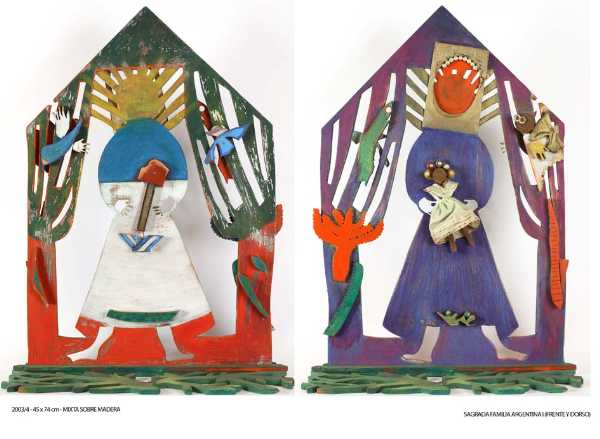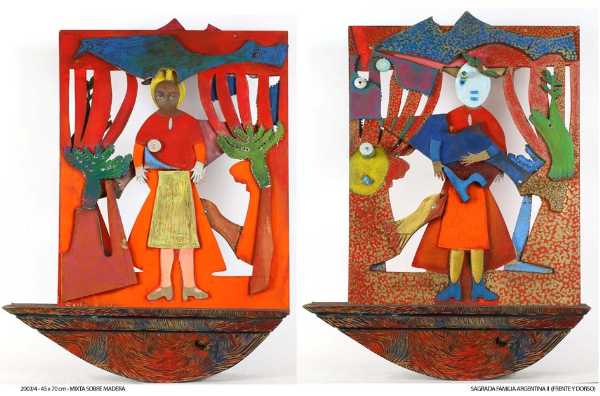Sacred Family

Sacred Family
The Destruction of Argentine Families in Times of Crisis
In times of economic crisis, many families have to make sacrifices. But how do these sacrifices affect the stability and longevity of that most important social unit: the family? Multimedia artist Perla Bajder uses sculpture to reflect on how financial uncertainty can lead to devastating degradation of families.

Sacred Family I
Mixed Media on wood. 50 x 70 cm. |

Sacred Family II
Mixed Media on wood. 50 x 70 cm. |

My Family
Mixed Media on wood. 40 x 60 cm. |

Relief from the Flood
Mixed Media on wood. 40 x 60 cm. |
Sacred Family explores the desecration of the family as the essential social institution. My work depicts fragmented and confused families, with ties that are slowly being eroded. Family members are being overwhelmed by the seemingly impossible pursuit of economic development. Because of the severe economic crisis, families have been transformed: a parent might leave their family to find work in another country; an elderly person cannot rely on their pension, so must move in with an already financially-stretched family; parents cannot afford to provide their children with the opportunities they want for them. All of these circumstances serve to divide families, weakening our society's most significant social unit.
In these situations of extreme economic crisis, state governments have not done enough to step in, and the wellbeing of individuals of all ages and social standing-elderly, young, middle class, poor-is neglected. Indeed, in some instances you can find whole families sleeping on the streets at night wrapped in blankets. In my work, the presence of women, mothers, and grandmothers act as guides in the family structure. They are stable, like driftwood in the middle of the sea; strong, tenacious, non-violent, capable of things men aren't.
The style of my work is influenced by my childhood; I come from generations of Polish carpenters, and many of my toys were handmade by carpenters in my family. I can remember the scents, textures, colors and images on the wood, all of which were instrumental in developing my imagination. Returning to the toys from my childhood, I use the same style to attempt to represent the current situation of families in Argentina.
EDITORIAL NOTES
Argentine families are still living in the shadow of the 2001 national financial crisis, which left 50 percent of the population below the national poverty line and widened the country's wealth gap severely (read our Argentina essay to learn more). Though the country's economy stabilized since then, when the global financial crisis reared its head in 2008, the government made the controversial move to nationalize private pensions to keep the country afloat, which left many breadwinners uncertain about the state of their retirement funds. With the nationalized pensions system, a set amount is payed out to pensioners, unlike a private system where pension values can increase or decrease depending on the market.
Since then, however, some strides have been made to stabilize families. For example, in 2009 the government created a Universal Child Allowance, a monthly cash benefit from the government given to workers for each child under 18. Additionally, in 2010 this benefit was extended to the unemployed and workers in the informal job market who have children. Now, nearly four million children receive the benefit, which amounts to about $60 a month.
ABOUT THE ARTIST
Perla Bajder is a painter, designer, writer and illustrator living in Buenos Aires. Her work has been exhibited in the Borges Cultural Center in Buenos Aires, The Museum of Fine Arts in Buenos Aires, and the Goethe Institute in Santiago, Chile. She received a Master's degree in drawing from the National School of Fine Arts in Buenos Aires. Perla Bajder is a first-generation Argentine.


